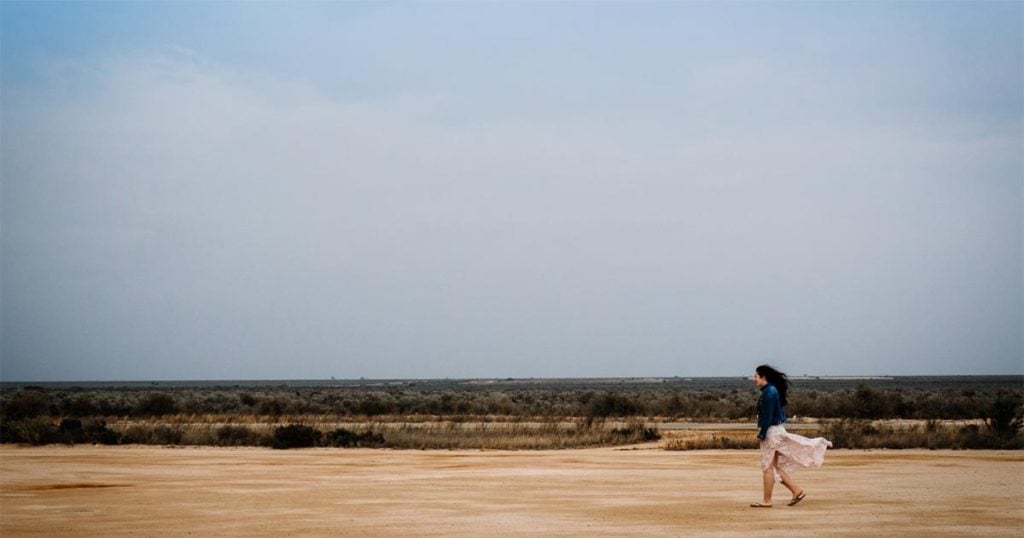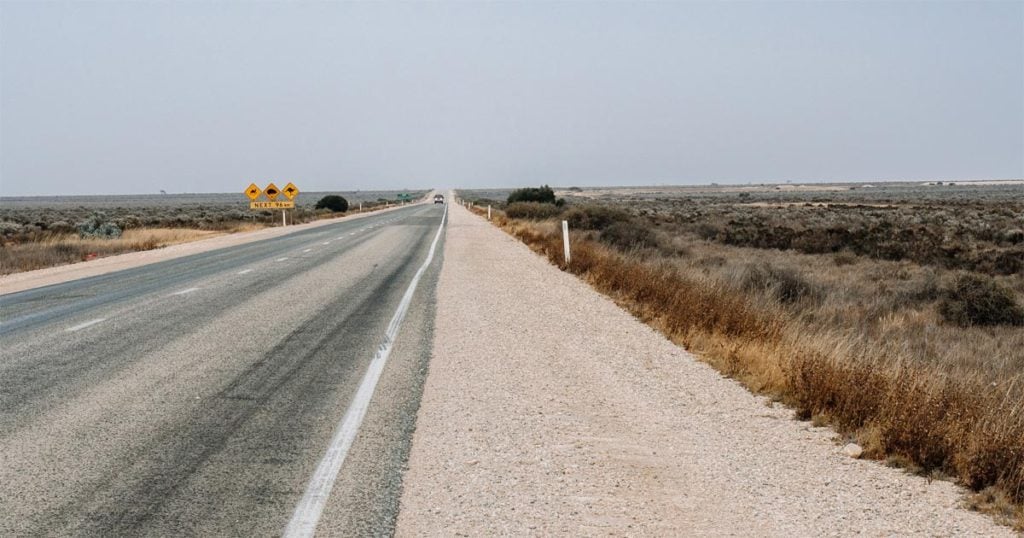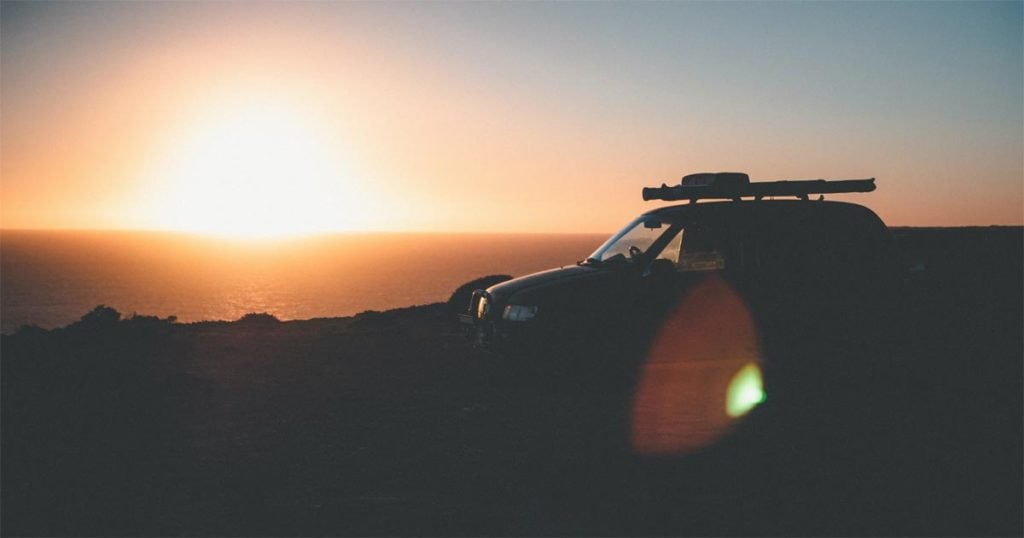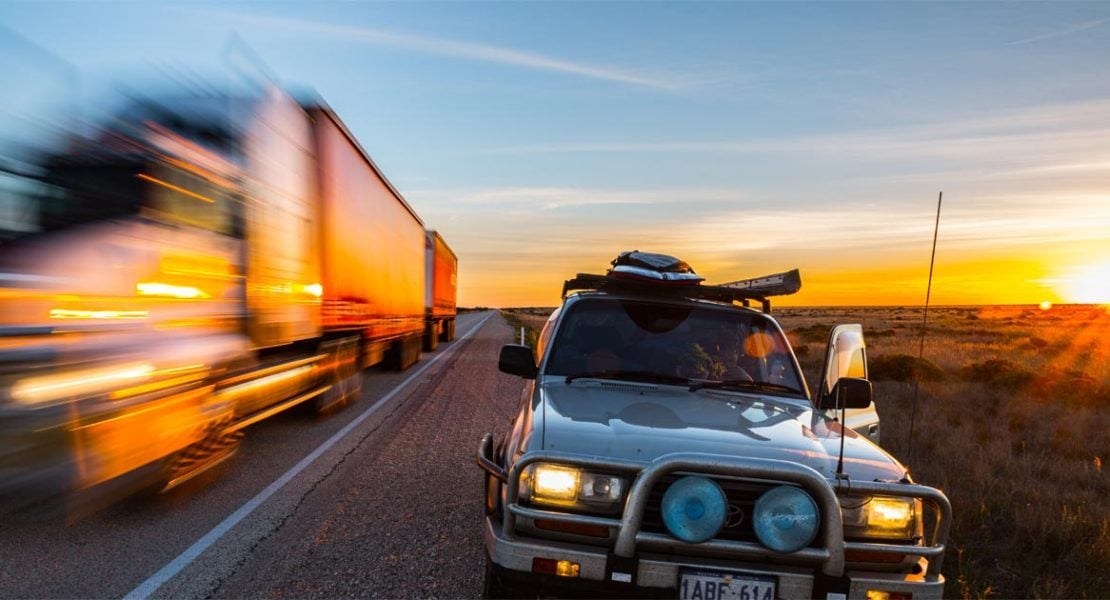Contents:
- Map
- Towns on the Nullarbor
- By Bike
- By Hike
- By Train
- By Car
- Accommodation
- Camping & Campervan
- Attractions
- FAQs
The Nullarbor Plain is a patch of semi-arid desert that stretches from the goldfields of Western Australia across to the Eyre Peninsula in South Australia. At 200,000 square kilometres it is the world’s largest single exposure of limestone bedrock, as well as one of those things that you can actually see from space.
The Nullarbor is peak Australia. It’s a patch of nothingness that seems to go on forever—nulla arbor is literally Latin for no trees—but the complete lack of any defining features makes this a unique and eerily beautiful part of the world. As such the 2700km drive between Perth and Adelaide across the Nullarbor Plain has become a rite of passage for many travellers.

Gorgeous oblivion aside, there are many other reasons to drive across the Nullabor. You can play Nullarbor Links, the world’s longest golf course. You can drive Australia’s longest stretch of straight road. You can also drop into one of the handful of pubs along the route and hear tales of the mythical Nullarbor Nymph.
There are plenty of reasons why you’d drive across the Nullarbor. Perhaps the more pressing question, then, is how?
Map
Where does the Nullarbor start and finish?
The Nullarbor starts in Norseman and ends in Ceduna.
How long does it take to drive across the Nullarbor
12.5 hours of non-stop driving, but we recommend a minimum of 2 days by car.
The Towns of the Nullarbor
For the purposes of this article we won’t describe the entire trip from Perth to Adelaide, but will instead focus on the stretch that curves around the Australian Bight, from Norseman in Western Australia to Ceduna in South Australia.
So, going from west to east, let’s take a look at the major (a relative word) stops on your journey across the Nullarbor Plain.
- Norseman: The beginning of your Nullarbor adventure, this is the town where you turn onto the Eyre Highway.
- Balladonia: A simple roadhouse stop found at the start of Australia’s longest stretch of straight road.
- Caiguna: The town at the other end of the almost 150km straight stretch.
- Cocklebiddy: A roadhouse town known for its caves, lakes and funny name.
- Madura: A stop famous for the natural blowholes of the Madura Pass scenic lookout, and a sprawling sheep station.
- Mundrabilla: Another station-cum-roadhouse, Mundrabilla is most famous for its namesake meteorite, the largest ever found in Australia.
- Eucla: 11km from the South Australian border, the beautiful coastal town of Eucla marks the start of Nullarbor National Park.
- Nullarbor Roadhouse: At the other end of the National Park, the Nullarbor Roadhouse is an oasis in the middle of nowhere.
- Yalata: This aboriginal community is the first true sign of civilisation on the South Australian side.
- Penong: Cactus Beach, Port Sinclair Pink Lake, a windmill museum; after the nothingness of the Nullarbor, Penong is almost overwhelming.
- Ceduna: The end of the Nullarbor and the beginning of the Eyre Peninsula, the 2000-strong town will feel more like a city.
There are a few other roadhouses and tiny settlements sprinkled throughout the journey, many strategically placed to ensure that there’s never more than 200km between one fuel stop and the next. But if you’re making an itinerary, choosing a handful of the communities above will put you in good stead.
Can You Bike, Hike or Train the Nullarbor?
‘What if I don’t want to drive?’ you ask. Not a problem, there are other ways to skin this desolate cat… although a couple of the options aren’t particularly tempting, as you’ll be trading in petrol for pasta.
Bike
The first person to cross the Nullarbor by bike was Arthur Charles Jeston Richardson in 1896, as part of his circumnavigation of Australia. He tackled the stretch in summer, and instantly regretted it. Since being sealed the Eyre Highways is a more common cycle route these days, although you’ll still need to be comfortable riding up to 200km between water stops, on the same tarmac as road trains, and in extreme conditions (perhaps avoid summer, hey Arthur?)
Hike
With their deep knowledge of the land, many indigenous peoples have managed the trek. Henri Gilbert, the first non-indigenous person to do it, completed the walk in the middle of the 1897-98 summer (early settlers apparently didn’t understand how Australian seasons worked.) Another notable walk was completed in 1985 by six young ‘Jesus Christians’, who didn’t think to take any supplies. They made it, thanks mainly to the kindness of passing motorists, although they preferred to thank God. Should you hike the Nullarbor? We’ll make it simple. No.
Train
The last and most reasonable alternate form of Nullarbor transport is offered by the Indian Pacific, a passenger train that travels between Perth (the Indian Ocean) and Sydney (the Pacific Ocean) on a regular basis. It crosses the Nullarbor in a day (and a bit of the night), offering incredible levels of totally unique scenery, as the line is a long way inland from the highway. You will have to spend a pretty penny to secure your seat, but in return you’ll enjoy the most relaxed and luxurious Nullarbor experience available.
Nullarbor Driving Information
What does a driver need to know about the journey?
- Length: the Norseman to Ceduna section described here covers 1200km, or 12.5 hours of uninterrupted driving. Perth to Adelaide meanwhile is a 2700km, 28 hour non-stop journey. It’s wise to split the journey up over a handful of days. Try to limit your daily driving to eight hours.
- Speed limits: The open roads have a speed limit of 110kph, lowering to 80kph or 60kph as you drive through towns and settlements.
- Driving at night: The main resident of the Nullarbor is the kangaroo. Unfortunately these beautiful creatures are quite fond of headlights. Avoid driving after dark where possible.
- Petrol stations: All the towns listed above (apart from Yalata) sell fuel. Rest assured you’ll never be more than 200km from a petrol station the entire drive.

Accommodation – best overnight stops on the Nullarbor
Hotels, Motels and Hostels… Where should I stay when crossing the Nullarbor?
While you shouldn’t expect the Ritz, there are many perfectly comfortable accommodation options along the journey. Working from west to east, the best overnight stops include:
1) Fraser Range Station
Fraser Range Station, one of the best overnight stops on The Nullabor Plain, offers a unique outback experience located on the western end of the Nullarbor. It provides a range of accommodations, including cabins and campsites. Nestled amidst picturesque surroundings, this stop allows you to immerse yourself in the region’s natural beauty. Stargazing opportunities here are exceptional, thanks to the remote location and clear night skies.
2) Wedgetail Inn Hotel
As you continue eastward, the Wedgetail Inn Hotel in Cocklebiddy beckons weary travellers. It’s a simple yet welcoming roadhouse with comfortable rooms and a restaurant serving hearty meals. The hotel’s friendly staff can offer valuable local insights, making it a great place to rest and refuel.
3) Border Village Roadhouse
Crossing the South Australian border, you’ll come across Border Village Roadhouse. This stop offers clean and comfortable accommodations and a refueling service station. It’s an ideal place to break your journey and enjoy some refreshments before continuing your Nullarbor adventure.
4) Nullarbor Roadhouse
The Nullarbor Roadhouse is a true oasis in the middle of the vast plain. Situated within the Nullarbor National Park, this roadhouse provides a range of options, from motel-style rooms to caravan sites. Its restaurant offers a variety of meals, ensuring you’re well-fed during your stay. The Nullarbor Roadhouse is an excellent place to rest and recharge before tackling the remaining leg of your journey.
5) Ceduna Foreshore Caravan Park
As you reach the end of the Nullarbor, Ceduna welcomes you with the Ceduna Foreshore Caravan Park. This comfortable accommodation across the Nullarbor provides cabins, caravan sites, and camping facilities. Located on the shores of Murat Bay, it offers a peaceful setting for relaxation. The town itself has more amenities and services, making it feel like a small city after the expanse of the Nullarbor.
Camping & Campervan Stops on Nullarbor
Can I camp in a tent along the Nullarbor?
You certainly can! The only caveat is that you’ll need to do so in a designated area. Thankfully, there are plenty of spots to do just that, most of which take the form of free roadside rest areas:
Is it safe to camp on the Nullarbor?
If you do your research, are prepared and carry the right equipment, then yes camping on the Nullarbor is safe. Many people do it each year. But follow local advice and do plenty of research. Keep your food sealed and in your car. Keep your tent zipped up and closed. Be alert to local wildlife. Also – make sure you have plenty of water at all times.
If you want a more spectacular spot to camp, there are a number of opportunities to stay the night in a national park, although a small fee will generally apply. Nature lovers should check out the following picturesque campgrounds, provided your vehicle is capable of getting there:
Attractions
Things to Stop and See En-Route…
For an area known for its nothingness, the Nullarbor has a fair bit going on. Be sure to check out the following sights and experiences on your journey:
- Eyre Bird Observatory: An avian research facility that’s a dream for bird watchers.
- Weebubbie Cave: A spectacular cave diving spot.
- Bunda Cliffs: Stunning limestone cliffs collapse into the bluest of water.
- Great Australian Bight Marine Park: World-class southern right whales watching from June to October and plenty of playful seals during the rest of the year at Great Australian Bight Marine Park.
- Koonalda Homestead: A slowly decaying homestead in the middle of Nullarbor National Park that’s a joy for photographers.
- Koonalda Caves: An underground cavern with Aboriginal rock art dating back 20,000 years.
- Nullarbor Links: This 18-hole golf course stretches 1365km across the Nullarbor, making it comfortably the longest in the world. Don’t expect much grass.

Conclusion
Nullarbor Plain is a remarkable and unique region in Australia, known for its vast, treeless expanse and stunning desolation. Traveling across the Nullarbor is a journey filled with adventure and natural beauty, offering a range of experiences for those willing to explore this remote landscape.
The Nullarbor has something to offer everyone, regardless of whether you prefer to drive, cycle, or take the Indian Pacific train. From the awe-inspiring coastal cliffs to the enigmatic caves, and from the rustic outback stations to the quaint towns along the way, this iconic journey offers a truly Australian experience.
So, whether you seek the thrill of the open road, the tranquility of camping under the stars, or the luxury of a train ride through the heart of the plain, the Nullarbor awaits, ready to captivate your spirit and leave you with lasting memories of its unique charm.
Nullarbor FAQs
Is the Nullarbor dangerous?
In the sense that it has a harsh environment, yes. In the sense that you’ll be robbed, no. Everyone is on the same exciting journey together, so there’s a real sense of community amongst travellers. The main danger is being exposed to the elements after a breakdown, so try not to stray too far from the highway.
How long does it take to drive the Nullarbor Plain?
The section described typically takes around 12.5 hours of continuous driving to complete. However, planning for stops and enjoying the scenic beauty along the way is recommended.
Where does the Nullarbor Plain start and finish?
Technically, the Nullarbor Plain stretches to the 1100km wide section of exposed limestone split over the SA/WA border. Still, for all intents and purposes, it can be treated as the area between Norseman and Ceduna.
Where do you stop when crossing the Nullarbor?
There are various unique stops along the Nullarbor, each with its own character. There’s no wrong choice, and it depends on your preferences and interests.
How much does it cost to drive across the Nullarbor?
The remote nature of the Nullarbor makes it relatively expensive. Plan for around $300 for fuel, up to $200 per night for quality accommodation, and approximately $50 per day per passenger for food.
Why are there no trees on the Nullarbor?
The Nullarbor is an area of exposed bedrock, and as such it simply doesn’t have enough soil to support much plant life. The harsh summer conditions don’t help either.
Is there phone reception on the Nullarbor?
Telstra, Australia’s biggest provider, offers almost complete coverage along the route. If you’re with Optus, Vodafone, or any other option though, you may be without signal for days.
What does the word Nullarbor mean?
The word Nullarbor is derived from the Latin nulla, the feminine ‘no’, and arbor, meaning ‘tree’. Rest assured, it offers what it says on the packet.
Is the Nullarbor Plain a desert?
While it’s called a plain, the Nullarbor is indeed a desert, as it has a desert climate with arid to semi-arid conditions.
Is the Nullarbor a sealed road?
Yes, the entire journey can now be completed on the sealed Eyre Highway (although many of the most interesting stops are a little off the beaten track.)

